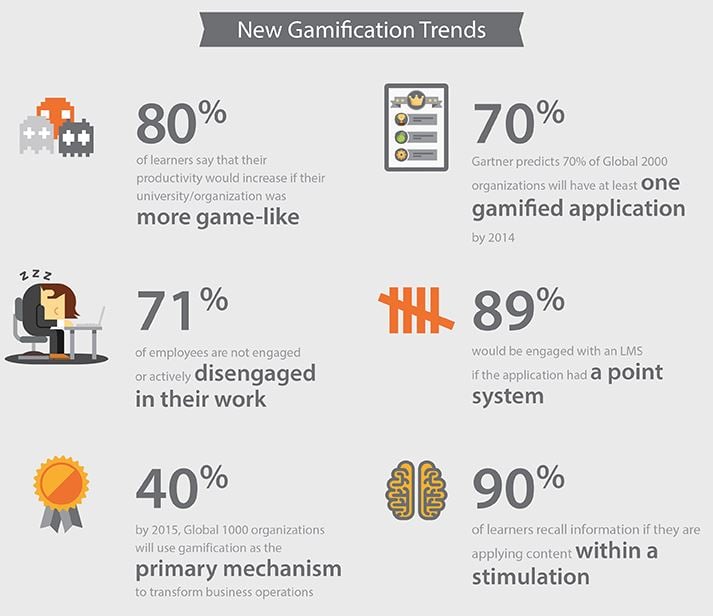Corporations rely on the skills and talent employees bring to their organizations. For sustained success clear goals and continuous corporate training are essential.
People bring their own talents and insights to the table while contributing to the conglomerate and adhering to the organization’s goals and policies. This can be a tricky distinction to make, and an even trickier one to incorporate properly.%20(1).jpg?width=1200&name=1200x627%20(6)%20(1).jpg)
In recent years, this balance has become increasingly difficult due to a falloff in the effectiveness of traditional corporate training techniques, leading to a scramble to develop new, more effective options.
One of these innovations is gamification, a training method that incorporates game mechanics to spark employee engagement and productivity in new and current employees.
The challenge many businesses encounter is that people and cultures are constantly evolving. To remain competitive in a world of flux, businesses need to take an outside-in approach keeping in mind employees and the market they cater to. This is where the evolution of corporate training can leverage innovations such as gamification.
During the recession of the 2000s, static and traditional training methods began to see a decline in return on investment (ROI). The pressure to stay competitive as companies started to recover, led to transformation. Now that the economy is recovering, corporations are revisiting corporate training with a fresh perspective. The new perspective comes with new insight and innovation.
In a revolutionized business environment, it is important to create innovative, effective training methods to retain talent and build an organization of excellence while profiting from a positive ROI.
How Gamification Increases Engagement
It can be easy to overlook or dismiss gamification as being a trendy or a high-risk, low-reward system that is mostly unneeded, but the use of gamification in employee training (and beyond) has been extensively studied.
From those studies, a correlation has emerged: correctly implemented elements of gamification result in an uptick in not only engagement, but in productivity and enjoyment. From employee engagement to worker retention, gamification is, at the very least, a worthwhile tool to investigate for yourself and consider incorporating into your own business.
It offers employees something better than monetary incentives—the incentive of self-investment. Being able to see progress and be acknowledged for that progress is a powerful motivator, both in the context of corporate training and in life beyond the workforce.
Corporations are built by people, and when those people thrive, so do the places they work. This is exactly what gamification recognizes and fosters—personal accountability and desire for growth, and through it, positive outcomes for the corporations utilizing it.
It's evident that gamification is the present and future of corporate training, simply trace the flow of money. Successful businesses tend to have extensive resources which, in turn, they invest to promote more growth and profit.
As such, you can typically ascertain how useful a particular tool is by how much money goes towards it. From 2012 to 2016, the worldwide gamification market grew from $242 million to $2.8 billion (Business.com).
The Value of Gamification for Organizations
Employee engagement is a tremendous issue that plagues all businesses. Time is money, and low engagement means that both are being wasted. In fact, studies have shown that employee engagement tends to hover around 30% in the US and 13% globally (Gallup).
Finding the most efficient way to combat these dismal numbers is priority for most employers. This is perhaps where gamification shines the brightest, as it not only provides the opportunity for positive progression in corporate training, but also has been proven to increase employee morale.

The incorporation of challenging, engaging game mechanics elements is inspiring and breaks up the monotony that can often set in during long days at the office, but more impactful than the actual game-play spin placed on day-to-day tasks is the desire for recognition that most people crave.
In fact, monetary rewards, such as bonuses and increased salaries, have been shown to be only minimally effective while recognition and status are correlated with increased motivation, productivity, and pride in work. In a survey of employees currently using gamification motivators, an incredible 91% reported that their work experience and productivity were improved (In Business).
Hand-in-hand with employee engagement comes worker retention. In a survey conducted by BambooHR, 31% of people stated that they had left a job within the first 6 months of being hired (Bamboo). The top reason for such a short-term stay? They felt as they were not contributing enough to the business in a timely fashion.
In other words, new employees want to learn the innerworkings of their job and feel productive as soon as possible. While actual contribution to the business may not be realistic from the word “go,” this problem can be mitigated by proper training that gives the impression (and reality) of working toward a particular outcome—in this case, the depth of involvement the new employee is seeking.
How Corporate Trainers Can Implement Gamification
There are many game play elements that can be incorporated into corporate training and lend themselves to both inspiring and encouraging new and retained workers alike. Each of these elements comes with its own unique benefits. For example, utilizing a system that tracks and publicly displays employee scores for particular learning activities can lead to several positive outcomes, including (but not limited to): a lighthearted spirit of competition, a sort of checkpoint or high score mentality that inspires participants to reach for the next level of achievement, and a distinctive pride in one’s improvement in both knowledge and production.
The idea of personal improvement is a powerful motivator. This, coupled with public acknowledgment of growth, creates a dynamic stimulus for personal accountability and sparks a deep-seated desire to expand one’s knowledge and skillset.
Blend evolved corporate training methods with established ones. Mixing a progress-based gamification system with milestone or objective-based rewards, for example, can further encourage employees by bringing a real-life or tangible aspect to the training activity.
The key is to continually evolve to meet an ever-changing behaviors and business environments. While gamification is a relatively new technique that has been proven to be effective, it is never too early to remain ahead of the curve. What is cutting edge today can be irrelevant tomorrow.






-1.jpg)
.jpg)
